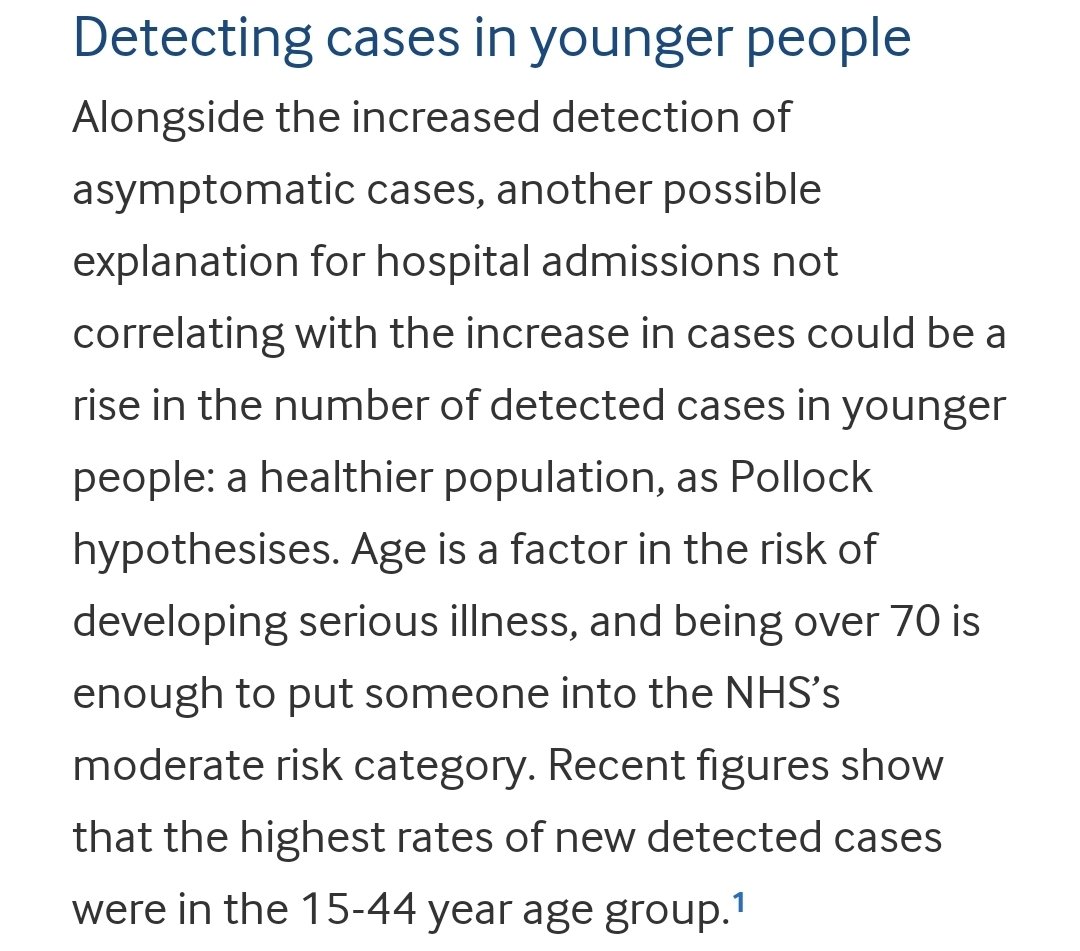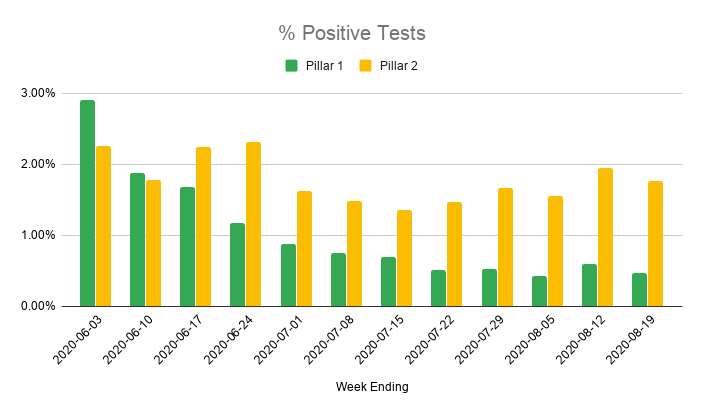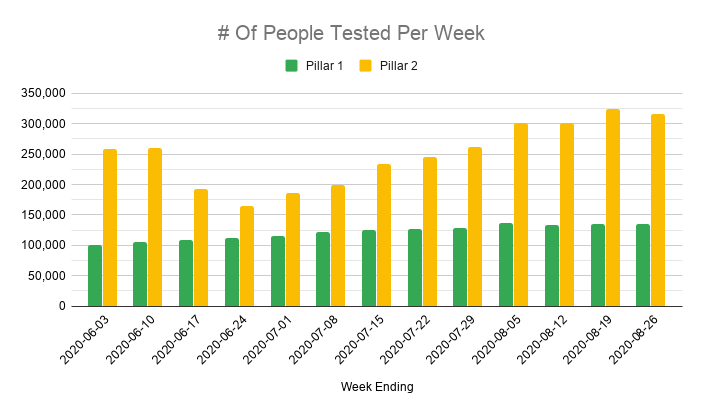After claiming last month that cases weren& #39;t rising (when they clearly were) due to errors in how he calculated the positivity rates, @carlheneghan is now saying that "while detected cases are rising, that is not the same as cases rising".
Does this argument hold any water? https://twitter.com/bmj_latest/status/1302215154386587649">https://twitter.com/bmj_lates...
Does this argument hold any water? https://twitter.com/bmj_latest/status/1302215154386587649">https://twitter.com/bmj_lates...
The key points are that -
1) there& #39;s no distinction in the data between symptomatic and asymptomatic cases.
2) swab tests can pick up remnants of the virus from an infection that someone fought off a few weeks earlier.
1) there& #39;s no distinction in the data between symptomatic and asymptomatic cases.
2) swab tests can pick up remnants of the virus from an infection that someone fought off a few weeks earlier.
The first point is valid in that it would be useful to know what % of new cases are asymptomatic.
But they still have the virus and may be infectious.
And as we don& #39;t know how many are asymptomatic, it& #39;s a leap to suggest this is having any significant impact on overall cases.
But they still have the virus and may be infectious.
And as we don& #39;t know how many are asymptomatic, it& #39;s a leap to suggest this is having any significant impact on overall cases.
@AllysonPollock says we count "cases identified through mass testing of asymptomatic people", but how much is happening and would it explain recent rises?
The ONS survey only found 71 cases in 6 weeks.
Regular testing of care homes has (sort of) been going on for 2 months now.
The ONS survey only found 71 cases in 6 weeks.
Regular testing of care homes has (sort of) been going on for 2 months now.
Testing is still constrained by lab capacity and, as @chrischirp pointed out yesterday, we still mostly test people with symptoms.
There seems to be some testing of asymptomatic people in hot spots, but is this enough to significantly skew the numbers? https://twitter.com/chrischirp/status/1302229547241418756?s=19">https://twitter.com/chrischir...
There seems to be some testing of asymptomatic people in hot spots, but is this enough to significantly skew the numbers? https://twitter.com/chrischirp/status/1302229547241418756?s=19">https://twitter.com/chrischir...
The second point is again valid in that not all cases detected may be current, but it feels like a bit of a red herring.
These aren& #39;t false positives but delayed positives, picking up people who were infected a few weeks ago but may no longer be sick or infectious.
These aren& #39;t false positives but delayed positives, picking up people who were infected a few weeks ago but may no longer be sick or infectious.
As most people are (as far as we know) still tested either because they have symptoms or as part of regular testing (in which case their last test should have picked up the infection already), it seems unlikely to me that this is responsible for the rise in cases recently either.
So the report does make some valid points.
Most importantly that we don& #39;t have data on symptomatic vs asymptomatic cases or the level of testing in each local authority area.
But that means any suggestion that active, symptomatic cases aren& #39;t really rising is just guesswork.
Most importantly that we don& #39;t have data on symptomatic vs asymptomatic cases or the level of testing in each local authority area.
But that means any suggestion that active, symptomatic cases aren& #39;t really rising is just guesswork.
What they& #39;re trying to explain is why cases are going up but the number of people in hospital isn& #39;t.
The far more likely explanation for this, as @AllysonPollock and the BMJ article say, is that most of the people catching it now are young and less likely to be hospitalised.
The far more likely explanation for this, as @AllysonPollock and the BMJ article say, is that most of the people catching it now are young and less likely to be hospitalised.
There& #39;s clear evidence to support THIS hypothesis, so the rest of the article and @carlheneghan& #39;s comments about the possible impact of test sensitivity and asymptomatic cases, for which there& #39;s no evidence due to the very lack of data they& #39;re highlighting, is purely speculative.
It& #39;s also worth noting both the number and percentage of people testing positive has risen steadily for two months, starting two weeks AFTER testing began ramping up again.
The rise also started two weeks after pubs reopened and social distancing was reduced.
Coincidence? https://abs.twimg.com/emoji/v2/... draggable="false" alt="🤔" title="Denkendes Gesicht" aria-label="Emoji: Denkendes Gesicht">
https://abs.twimg.com/emoji/v2/... draggable="false" alt="🤔" title="Denkendes Gesicht" aria-label="Emoji: Denkendes Gesicht">
The rise also started two weeks after pubs reopened and social distancing was reduced.
Coincidence?
To me it seems most likely that easing of restrictions and social distancing is causing the rise in cases, and the high proportion of young people catching it explains why hospitalizations aren& #39;t going up (yet) as well.
By comparison, suggesting without real evidence that the rise is due to testing picking up more and more old and asymptomatic cases (both in total and as a proportion of the number of people tested), at steadily increasing rates for the last two months, seems rather far fetched.

 Read on Twitter
Read on Twitter
 " title="It& #39;s also worth noting both the number and percentage of people testing positive has risen steadily for two months, starting two weeks AFTER testing began ramping up again.The rise also started two weeks after pubs reopened and social distancing was reduced.Coincidence? https://abs.twimg.com/emoji/v2/... draggable="false" alt="🤔" title="Denkendes Gesicht" aria-label="Emoji: Denkendes Gesicht">">
" title="It& #39;s also worth noting both the number and percentage of people testing positive has risen steadily for two months, starting two weeks AFTER testing began ramping up again.The rise also started two weeks after pubs reopened and social distancing was reduced.Coincidence? https://abs.twimg.com/emoji/v2/... draggable="false" alt="🤔" title="Denkendes Gesicht" aria-label="Emoji: Denkendes Gesicht">">
 " title="It& #39;s also worth noting both the number and percentage of people testing positive has risen steadily for two months, starting two weeks AFTER testing began ramping up again.The rise also started two weeks after pubs reopened and social distancing was reduced.Coincidence? https://abs.twimg.com/emoji/v2/... draggable="false" alt="🤔" title="Denkendes Gesicht" aria-label="Emoji: Denkendes Gesicht">">
" title="It& #39;s also worth noting both the number and percentage of people testing positive has risen steadily for two months, starting two weeks AFTER testing began ramping up again.The rise also started two weeks after pubs reopened and social distancing was reduced.Coincidence? https://abs.twimg.com/emoji/v2/... draggable="false" alt="🤔" title="Denkendes Gesicht" aria-label="Emoji: Denkendes Gesicht">">
 " title="It& #39;s also worth noting both the number and percentage of people testing positive has risen steadily for two months, starting two weeks AFTER testing began ramping up again.The rise also started two weeks after pubs reopened and social distancing was reduced.Coincidence? https://abs.twimg.com/emoji/v2/... draggable="false" alt="🤔" title="Denkendes Gesicht" aria-label="Emoji: Denkendes Gesicht">">
" title="It& #39;s also worth noting both the number and percentage of people testing positive has risen steadily for two months, starting two weeks AFTER testing began ramping up again.The rise also started two weeks after pubs reopened and social distancing was reduced.Coincidence? https://abs.twimg.com/emoji/v2/... draggable="false" alt="🤔" title="Denkendes Gesicht" aria-label="Emoji: Denkendes Gesicht">">


